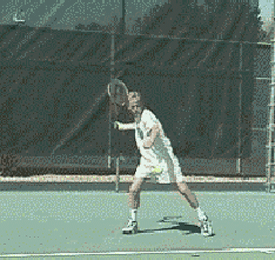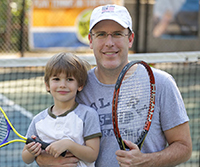The Forehand:
A Spring Event
Jeff Counts
When I watch professional tennis, I see the same things you do. Rackets whipping around the body. Incredible racket head speed resulting in blistering pace and spin. This visual evidence, combined with tennis commentator's awe at today's "racket head speed" makes me instinctively want to jump on a court and start whipping and snapping to achieve that elusive power only the pros seem to generate. And I do, in fact, see people attempt to do this every time I step foot on a court.
The unfortunate reality, however, is that this visual feedback serves up one illusion after another. John Yandell, in his seminal "Myth of the Wrap" article (Click Here) explains how high speed video gives us a very different picture of what happens just before, on, and well after contact. The video footage in that article clearly shows the wrist staying back through contact and moving forward, not across the body, on the forehand side. And there is an entire "double bend" structure as well that puts the shoulder in a powerful position to enhance the spring dynamic between racket and ball.
After seeing the evidence, I had no trouble believing in the double bend or the stable back wrist through contact, but I was mystified at how power could be generated with such a fixed structure as the double bend. Our bodies scream to swing and slap and whip the arm into the ball on the forehand because we instinctively feel this is where power comes from. Professionals, however, were doing none of these things. Why? And where exactly was their power coming from?
In my quest to uncover an elusive power source, I began videotaping pro strokes on my own, and managed to play with the shutter speed and software settings until I found a way to capture 60 frames a second-twice that of ordinary video. After going through hours and hours of video footage of pro tennis, studying and comparing their technique, I noticed that on certain shots I would actually catch the ball compressing into the strings in a remarkable way. The ball would compress into the string bed, flatten out, and almost disappear, Houdini like. The next frame would show the ball springing away from the racket, having returned to its normal, decompressed state.
Now things started to make some sense. The double bend and laid back wrist were necessary to provide a support system for the racket to absorb the ball. If the racket didn't have a solid support system behind it, there would be nothing for the ball to compress into and rebound off of. Think of every time you hit against the wall. The wall doesn't swing. Yet the ball comes back at you very, very quickly. The reason, of course, is that there is a solid mass for the ball to squash into and then rebound off of. The double bend functions in a similar way, as a wall of support that absorbs and then launches back the ball.
Now I had never heard of tennis as being a "spring based" game, so I decided to research the physics of tennis. I found a well regarded book by a team of the world's top tennis scientists, Rod Cross, Howard Brody, and Crawford Lindsay. It's called "The Physics and Technology of Tennis". (Click Here to find out more about this great, if dense, study of the physics of our game.)
I scanned the table of contents, and bingo, found what I was hoping for. Chapter 13, "Tennis Springs: Racquets, and Balls as Springs". Here is a quote from that chapter: "Tennis balls and tennis strings can be regarded as springs, for the simple reason that they ARE springs...In fact, all objects behave as springs, but not all objects are designed to compress or stretch as their main function. Strings are designed to stretch, balls are designed to compress..."
If you have seen "Torando Cam" footage, occasionally aired during Grand Slam events and now floating around the web, you see just how much spring is built into a tennis racket meeting a tennis ball. (Click Here to see some of it yourself.) First the ball pushes the strings backwards into the frame, creating a rubber band effect. Then the ball compresses into itself and squashes up like a pancake. Then you see the strings spring back, like a mini trampoline, launching the ball back. As the ball springs off the strings, it uncompresses back to it's original size.
Our book refers to the ball "squashing" and "ejecting" off strings that "stretch, vibrate, store and return energy". With the tornado cam footage you can actually see the strings continue to vibrate after the ball has left. It's an extraordinary glimpse into what professional forehand contact looks like at the level of physics.
So this concept of the contact as a spring event helps us understand the need for the double bend through contact. By providing an unchanging, solid support system to absorb the ball as it compresses into the strings, the double bend maximizes the chance of transferring the maximum possible energy into the shot.
I would like to suggest that the pros naturally amplify the "spring effect" built into racket and ball not only through the double bend, but by using their bodies to spring out with the ball as it is rebounding. The hand and wrist stay back facing the ball, but the racket and shoulder and arm all spring forward (and lift upward). You can see this in the rotation of the back shoulder, pushing the double bend structure forward. This all contributes to the great forward extension of the swing that we see in pro tennis, but that is sadly lacking in so many players who think they are imitating the pros.
All this is very similar to what my fellow contributor Bungalow Bill has written in his excellent analysis of Mark Phillippoussis's one handed backhand. As Bungalow Bill writes of Philippoussis: "His arm is basically a lever that is connected to a hinge known as his shoulder joint...This allows his racket to stay on course to hit the ball cleanly. The racket is not pulled away or sideways towards his right side which causes numerous errors." (Click Here to read the entire article.)
This notion of extension up and out with the ball is, I think, much easier for us to accept on the backhand side because it is much more obvious visually. The hitting arm is straight and locked, and the extension of this hitting arm is fairly clear even without the aid of video. Although there is a deceleration phase and a wrapping motion on the one-hander, it's much less extreme than on the forehand.
Perhaps on the forehand we can understand the "double bend" function by looking at it in the same way. If you look closely at the examples of forward extension in the above clip, you will notice that, just as described in the Philippoussis backhand, it is the shoulder that is lifting and driving a lever (the double bend) in a powerful thrusting motion. This lift and extension from the shoulder allows the racket to do what it should be doing --absorbing the ball for clean contact and maximum spring. This is much more difficult to achieve if you are swinging across the ball or slapping/snapping at the ball. And you will get no extension and lift from the shoulder because the racket head will swipe across the body.

Think about how Bungalow Bill's description relates to the forehand, and I think you will see that the principles are almost identical for both shots, even though at full speed the forehand and backhand look so different. A lever based extension through contact is the perfect way to maximize spring. It maximizes the chance the ball will be fully absorbed into the strings. The shoulder and the body then lift and extend the lever as the ball rebounds away. This in turn maximizes the transfer of energy into the shot-that is into velocity and spin.
My hypothesis is that if the racket starts to come across the body too soon that you reduce the efficiency of forward collision and the transfer of energy both from the racket itself and the body. This is what I observe time and again in so many players trying to copy the pros. The racket head swings around, the double bend breaks down, and there is no solidity behind the ball on contact. Although it is almost invisible to the naked eye, the pros do the opposite. They spring up and forward in harmony with the ball.
This visual illusion on the forehand--of racket head speed and the various wraps across the body--rather than levers, extension, and clean contact, is a trap that ensnares many players and coaches. The video revolution in tennis teaching and coaching is starting to change this. I hope this article helps us reconsider exactly what we are really "seeing" when we watch and study professional forehands. If you are willing to make use of this information, it can also make a huge difference in your ability to generate the pace and heavy shot making we all hope for when we try to copy the pros.
A topic for further exploration, and perhaps a future article, is how the pros use torso rotation, an inside out path of the racket, and contact in front of the body to generate speed without comprosing the double bend and extension from the shoulder like the junior player in the last animation.




